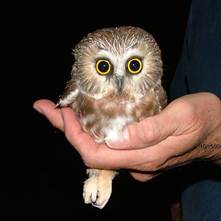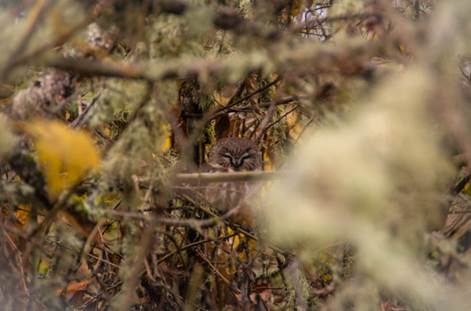“Owl,” said Rabbit shortly, “you and I have brains. The others have fluff. If there is any thinking to be done in this Forest–and when I say thinking I mean thinking–you and I must do it.” A.A. Milne, The House at Pooh Corner
This is a small owl with a wide breeding distribution across North America ranging from SE Alaska, across Canada to Nova Scotia, across the western U.S. and into Mexico. Some will migrate south for the winter where they can be found from the mid-west to as far south of Florida but it can be found in the winter through much of its breeding range. Saw-whet owls are found in coniferous and deciduous forests with thickets of second-growth trees or dense shrubs. They seem to prefer deciduous forests where woodpeckers excavate tree cavities that they can use as nest sites. These owls are often found in dense, swampy forests.
They are small owls, 7-8 inches long weighing a mere 4.5 ounces. They are nocturnal and become active around dusk and spend much of the day, well, doing much of nothing other than perched in a secure spot. Their color makes them quite catalogued and they will often pull one wing around their body to further obscure themselves. Their facial disc is brownish with a white zone around the eyes that for radial streaks towards the edge. The rest of the head is a rusty brown or grey-brown. The eyes are yellow and the eyebrows, forehead, and lores (area around beak) are white and form a vague “X” on the face.
They feed almost exclusively on small mammals, primarily deer mice. They also take shrews, voles, bats, and flying squirrels. Like other owls, they will swallow their prey whole or in pieces, including the bones. Their digestive system will take care of the good parts and then form the indigestible fur, bones, teeth, and whatever into a “pellet” that eventually is expelled through the mouth. I’ve occasionally come across owl pellets and you can take them apart and figure out what the owls have been eating – especially if you are familiar with small mammal teeth. A useful skill and conversation ice-breaker at parties.

Because they are nomadic it is unlikely that pair bonds are permanent or that birds often return to the same nest cavity. Males start territorial singing in late March – early April, hoping to attract a female. When one shows up he will fly in circles above her while calling. Often a mouse is offered as a courtship gift. Nests are most often found in pileated woodpecker or northern flicker cavities but they will readily use artificial nest boxes. An average clutch is 5-6 eggs that take about 25 days to hatch. The young fledge after 4-5 weeks.
The name of the owl comes from the sound of its call Saw-whet call — supposedly it reminded someone of a bladed being sharpened or “whetted”.
Aegolius, from the Latin meaning bird of prey but also similar to the Greek aigolios” meaning a bird that is an evil omen, and acadicus – of Acadia.
Connie and I go down to the nearby Nisqually National Wildlife Refuge near Olympia every year the day after Thanksgiving, turkey sandwiches in hand, to see what is out and about. At the visitor center bird log I noted that folks were seeing a saw-whet nearby so asked, and then got precise directions of where to go with the note that “..oh, there will be handful of folks there”.
As we got close to the site we met a fellow coming back who was carrying a camera and with a huge telephoto. His stuffed owl doll pinned on his pile jacket gave him away as an enthusiastic “owler”. He excitedly asked “Are you going to see the owl!?”.
Of course we were! And then he proceeded to tell us the movement history of the owl the past week and ended with – “….so now it is back at the perch where it was on Wednesday”.
Ya gotta lover birders.
And you have to admire their persistence. I cannot I imagine that I could have found this little puffball if someone told me to find it in some 100 yard length of forest. It took me about a minute to find it with help from people and it was only 20 ft. away.

